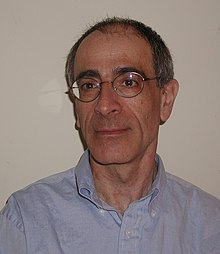G. Marius Clore MAE, FRSC, FMedSci, FRS is a British-born, Anglo-American molecular biophysicist and structural biologist. He was born in London, U.K. and is a dual U.S./U.K. Citizen.[1][2][3] He is a Member of the National Academy of Sciences,[4] a Fellow of the Royal Society,[5] a Fellow of the Academy of Medical Sciences, a Fellow of the American Academy of Arts and Sciences, a NIH Distinguished Investigator, and the Chief of the Molecular and Structural Biophysics Section in the Laboratory of Chemical Physics of the National Institute of Diabetes and Digestive and Kidney Diseases at the U.S. National Institutes of Health.[6][7] He is known for his foundational work in three-dimensional protein and nucleic acid structure determination by biomolecular NMR spectroscopy,[8] for advancing experimental approaches to the study of large macromolecules and their complexes by NMR,[9] and for developing NMR-based methods to study rare conformational states in protein-nucleic acid[10] and protein-protein[11] recognition.[12] Clore's discovery of previously undetectable, functionally significant, rare transient states of macromolecules has yielded fundamental new insights into the mechanisms of important biological processes, and in particular the significance of weak interactions and the mechanisms whereby the opposing constraints of speed and specificity are optimized. Further, Clore's work opens up a new era of pharmacology and drug design as it is now possible to target structures and conformations that have been heretofore unseen.[13]
- ^ Samoray C (2016). "Profile of Marius Clore". Proceedings of the National Academy of Sciences of the United States of America. 113 (45): 12604–12606. Bibcode:2016PNAS..11312604S. doi:10.1073/pnas.1616528113. PMC 5111653. PMID 27799541.
- ^ Clore, G. Marius. "Curriculum Vitae" (PDF). NIDDK. Retrieved 26 June 2020.
- ^ "American Institute of Physics Oral History Interviews - Marius Clore interviewed by David Zierler". AIP. 24 June 2020. Retrieved 26 June 2020.
- ^ "G. Marius Clore". Member Directory. National Academy of Sciences. Retrieved 12 March 2015.
- ^ "G. Marius Clore". Member Directory. Royal Society. Retrieved 29 April 2020.
- ^ "G. Marius Clore, MD, Ph.D., NIH Distinguished Investigator". National Institutes of Health Intramural Research Program. Retrieved 14 August 2018.
- ^ "G. Marius Clore, MD, Ph.D., FRS, NIH Distinguished Investigator". National Institute of Diabetes and Digestive and Kidney Diseases. Retrieved 14 August 2018.
- ^ "New Members and Foreign Associates of the National Academy of Sciences: G. Marius Clore, Gregory C. Fu, Sir J. Fraser Stoddart, Ei-ichi Negishi". Angewandte Chemie International Edition. 53 (26): 6598. 2014. doi:10.1002/anie.201405510.
- ^ Ringe D (1988). "Protein structure: an extra dimension to NMR". Nature. 332 (6162): 303. Bibcode:1988Natur.332..303R. doi:10.1038/332303a0. PMID 3352729. S2CID 32312775.
- ^ Dahlquist FW (2006). "Slip sliding away: new insights into DNA-protein recognition". Nature Chemical Biology. 2 (7): 353–354. doi:10.1038/nchembio0706-353. PMID 16783338. S2CID 12357797.
- ^ Blundell TL, Fernandez-Recio J (2006). "Cell biology: brief encounters bolster contacts". Nature. 444 (7117): 279–280. Bibcode:2006Natur.444..279B. doi:10.1038/nature05306. PMID 17051147. S2CID 4397989.
- ^ "Clore named Royal Society Fellow". Retrieved 1 June 2020.
- ^ Deshmukh, L, Tugarinov V, Appella DH, Clore GM (2018). "Targeting a dark excited state of HIV-1 nucleocapsid by anti-retroviral thioesters revealed by NMR spectroscopy". Angewandte Chemie International Edition. 57 (10): 2687–2691. doi:10.1002/anie.201713172. PMC 6034507. PMID 29345807.
